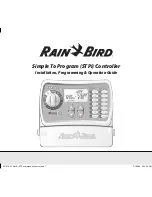
67
Note: Use a twisted-pair,
shielded cable. Use of
non-shielded cables may
result in radio wave
emission levels higher than
permitted under the
compliance
regulations listed.
The wires are routed through the right conduit hole (see Figure 17 on page 63) and are
hooked up to J1 and J3 on the front panel (see Figure 18 on page 64). The shield wire is
connected inside the back cover (see Figure 17 on page 63). For voltage output, a resistor
across the recorder input lines is needed. The resistor must be connected only if the
recorder requires a 0 to 10 V, 0 to 1 V, or 0 to 100 mV input. The resistor must be
connected at the recorder input terminals, not at the EC1000 output terminals. Ordinary
5% or 10% tolerance resistors are acceptable, as the controller’s output can be trimmed to
provide the proper voltage. Use a 1/4 watt resistor for a 0 to 10 V signal. Use a 1/8 watt
resistor for 0 to 1 V or 0 to 100 mV signals. Use a 500 ohm resistor for 0 to 10 V signal.
Use a 50 ohm resistor for 0 to 1 V signal. Use a 5 ohm resistor for 0 to 100 mV signal. The
controller’s 4 mA output must be trimmed to 0 mA.
Refer to Section 2.2.2 Recorder Output.
5.6.5
Electrode Wiring
Be sure the power is turned off to the controller. The electrode cable has a quick
disconnect coupling on one end which attaches to the electrode body. Route the electrode
cable into the controller through the right conduit hole (see Figure 17 on page 63). There
are four color coded wires and a shield wire inside the electrode cable. The color coded
wires are connected to the only four-pin removable plug in the controller J2 connector
as follows:
Note: The shield must be
connected to provide a
stable electrical signal
between the electrode
and the meter.
white--pin 1 / green--pin 2 / black--pin 3 / red--pin 4
The shield wire is connected inside the back cover (see Figure 17 on page 63). The
electrode cable can be wired directly to an optional junction box that is permanently
wired to the controller. The junction box has eight blank terminals located behind the
inside cover.
5.6.6
Electrode Output Connections
IMPORTANT NOTE: Turn off power to the pH/ORP Analyzer before disconnecting the
electrode at the quick disconnect. Failure to do so may result in permanent electrode damage.
Note: The shield must be
connected to provide a
stable electrical signal
between the electrode
and the meter.
If the measuring instrument is within 6 m (20 feet) of the electrode, the output cable is
supplied for the final connection. If the distance is greater than 6 m (20 feet), use the four
conductor cable, Cat. No. 46894-00, and junction box, Cat. No. 47122-00. Both cables
contain four conductors and a quick disconnect fitting. Refer to Section 5.6.5 Electrode
Wiring and to the table below for additional wiring information.
ELECTRODE
PREAMPLIFIER
White
pin #1
Green
pin #2
Black
pin #3
Red
pin #4
Содержание EC1000
Страница 2: ...2...
Страница 8: ...8...
Страница 12: ...12...
Страница 14: ...14...
Страница 16: ...16...
Страница 18: ...18 Figure 1 Controller Front Panel...
Страница 20: ...20 Figure 2 Pump Module...
Страница 24: ...24 Figure 6 pH Control Loop...
Страница 54: ...54...
Страница 56: ...56...
Страница 58: ...58 Figure 12 Controller Installation Panel Mount...
Страница 61: ...61 Figure 15 Installing the pH ORP Electrode Figure 16 Flow Thru Cell...
Страница 70: ...70...
Страница 73: ...73 6 4 Calibration See Section 2 3 Calibration Figure 21 Priming Tee Operation...
Страница 74: ...74...
Страница 80: ...80...
Страница 83: ...83 Figure 24 Sensor Replacement...
Страница 85: ...85 Figure 25 Hach One pH Process Electrode...
Страница 89: ...89 Figure 26 Pump Module Plumbing Diagram...
Страница 102: ...102...
Страница 103: ......
Страница 104: ......
Страница 105: ......
Страница 106: ......
Страница 108: ...108...
Страница 112: ...112...
Страница 116: ...116...
Страница 122: ...122...
Страница 123: ...123...
Страница 124: ......
















































